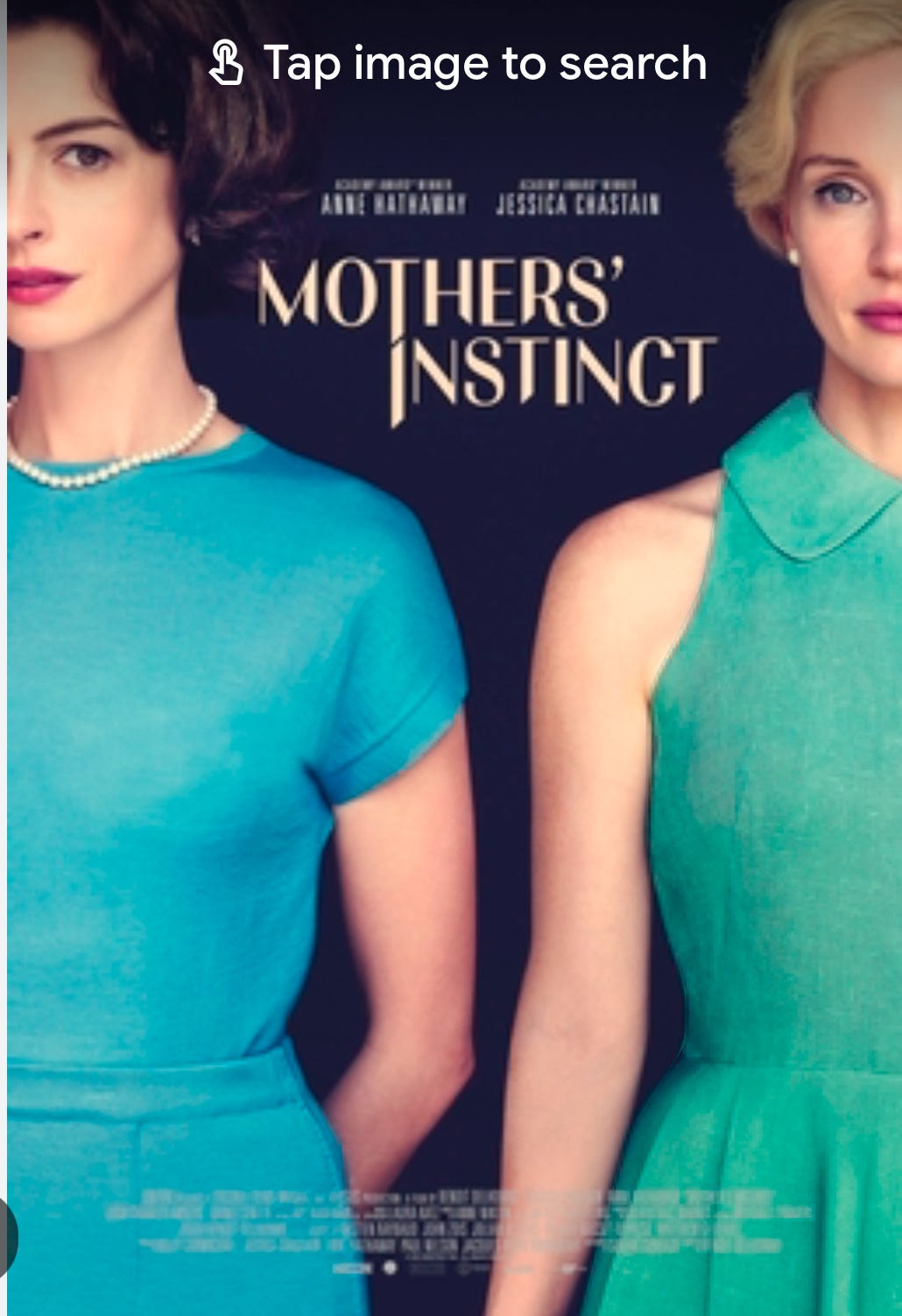"Women are mad, crazy and emotional"
Moms with Borderline Personality, Autistic Females and Borderline Personality Misdiagnoses, "Mother's Instinct" and Mad, Crazy Women: A Psychological Film Review, Snickerdoodle Cookies
I will never forget a particularly relevant therapy session I had several years ago. My therapist and I were talking about my mom’s “love” for me. I was telling her that in spite of my mom’s (and dad’s) emotional and psychological abuse - I know that my parents loved me. Then she replied “Ok, but is that what real love is supposed to feel like?” I found myself feeling really confused.
In fact, being confused is a highly common state for children with emotionally unsafe, unpredictable and/or immature parents. Why?
While no parent is perfect, when we are raised by parents who are capable of telling us they love us, but also raised by parents who are capable of calling us terrible names, accusing us of horrific intentions, giving us the silent treatment, punishing us, or even worse - our little child brains struggle to make sense of it all.
How can my own mother who “loves,” me think so badly of me?
How can she seemingly also “hate,” me when she’s mad at me?
This is the ultimate dilemma inherent in having a parent who struggles with something like Borderline Personality —as parents who have BPD also tend to display the Disorganized or Fearful Avoidant Attachment Pattern.
In this style, a child faces the ultimate fear-driven dilemma: what do I do when the person who is supposed to comfort and protect me is also the reason I need comfort and protection?
Thinking about my mom’s complexity is what drove this week’s post and focus, and when I heard someone say “I was a good mom, it’s just that I have a selfish, ungrateful, spoiled (ie bad) daughter,” — I felt like that summarized exactly how my mom thinks of me.
But I am here to tell you, both as a daughter of a mom who struggles, and as an expert in helping people heal when they were raised by emotionally immature parents — you are not selfish, spoiled, ungrateful, self-centered, a bad person, a bitch, a p.o.s., lazy or any other harmful name she (or he or they) have called you.
In fact, while it doesn’t necessarily heal your mother wound, it is important to know that as a result of something called “splitting” (quite common among parents with Narcissism, Borderline, Immaturity, etc) - your parent is often struggling with feeling bad inside themselves. They can’t hold that badness inside, so they dump it onto you- essentially saying “Here, you hold this for me because it feels too bad for me to hold it.”
What is splitting?
Splitting is a defense mechanism commonly seen in people with Borderline Personality Disorder (BPD) and with Narcissistic Personality Disorder (NPD).
“Research indicates that individuals with borderline personality disorder (BPD) and narcissistic personality disorder (NPD) "split" because of a complex interplay of factors, including deep-seated emotional dysregulation, intense fear of abandonment, a fragile sense of self, and a primitive defense mechanism to cope with perceived threats —often viewing people as entirely good or bad, right or wrong, with no middle ground. This can manifest in a parent who rapidly shifts between idealizing you and devaluing you (or others) in their relationships.”
Characteristics of Splitting:
Idealization Example: “You’re the best daughter ever, I am so proud of you.”
Devaluation Example: “You’re selfish and ungrateful. You’re a piece of shit daughter.”
Sound confusing? It is! Research continually demonstrates that being confused is a highly common state for children who experience childhood maltreatment at the hands of their parents. This is an example of emotional abuse - the most common form of childhood abuse.
Statistics on Childhood Abuse:
“Childhood maltreatment consists of abusive or neglectful acts perpetrated by parents or caregivers having the potential to “harm or threaten a child.”
Five subtypes of childhood maltreatment are commonly recognized: physical abuse, emotional abuse, sexual abuse, physical neglect and emotional neglect.
In terms of prevalence, a worldwide meta-analysis estimated rates of 12.7% for sexual abuse, 16.3% for physical neglect, 18.4% for emotional neglect, 22.6% for physical abuse, and 36.3% for emotional abuse .
These data indicate that childhood maltreatment is globally widespread, affecting the lives of millions of children. Exposure to childhood maltreatment has been associated with a variety of psychiatric disorders in adults, such as depression and anxiety disorders, bipolar disorder, eating disorders, personality disorders, and trauma-related disorders, such as post-traumatic stress disorder (PTSD).”
When those with BPD or NPD split, we also often see strong and intense emotions such as rage, fear, guilt tripping or shame. As a result, this behavior often contributes to relational conflict and instability, and the most common core fear for those with Borderline Personality: fear of abandonment.
Why do people split?
As a result of the common childhood trauma which accompanies BPD/NPD- and associated abuse/neglect they endured, splitting may act as a type of defensive and protective mechanism against managing overwhelming emotions, confusing patterns of parental behavior, etc.
“She’s not crazy or mad”
Moms with Borderline Personality are not mad or crazy, they are suffering human beings. But until we talk honestly about their suffering, as well as how their children suffer - minimizing them to “being crazy,” will continue to hurt everyone involved, and intervention will remain elusive.
If you have someone in your life who uses splitting and then you feel badly about yourself — work on separating from them both physically and mentally, work on setting boundaries and holding them, engage in trauma therapies, do inner child and inner parenting work, and learn nervous system regulation strategies.
The Female Phenotype of Autism or Emotional Instability Personality Disorder?
"Female" Autism or Borderline Personality?
Newest Research on Borderline Personality Disorder:
Key Wounds to Work On When Raised By a Parent with Borderline and/or Narcissistic Personality Disorder (Emotionally Immature Parents):
The Best Snickerdoodle Cookie Recipe *Gluten Free Flour*
Recipe from: modernhoney.com (I just found this online!)
As mentioned - I replaced flour with Gluten Free Flour!
I have a crazy sweet tooth and even though I try to watch my balance of fruits, veggies and protein - I love to bake and sugar is a bestie:). I know, it’s not great for auto immune and other issues, but sometimes, a girl and her kids just need cookies. I started using these gluten free flours with baking and most of the time it tastes as good or better than regular flour.
I love the brands Bob’s Red Mill and Cup4cup!
Ingredients
• 1 cup Unsalted Butter (softened)
• 1 1/2 cups Sugar
• 2 large Eggs
• 2 teaspoons Vanilla
• 2 3/4 cup gluten free flour
• 1 1/2 teaspoon Cream of Tartar (for less tang, use 1 teaspoon)
• 1/2 teaspoon Baking Soda
• 3/4 teaspoon Salt
Cinnamon-Sugar Mixture:
• 1/4 cup Sugar
• 1 1/2 Tablespoons Cinnamon
Instructions
1. Preheat oven to 350 degrees.
2. In a large mixing bowl, cream butter and sugar for 4- 5 minutes until light and fluffy. Scrape the sides of the bowl and add the eggs and vanilla. Cream for 1-2 minutes longer.
3. Stir in flour, cream of tartar, baking soda, and salt, just until combined.
4. In a small bowl, stir together sugar and cinnamon.
5. If time allows, wrap the dough and let refrigerate for 20-30 minutes. Roll into small balls until round and smooth. Drop into the cinnamon-sugar mixture and coat well. Using a spoon, coat for a second time, ensuring the cookie balls are completely covered.
*To make flatter Snickerdoodles, press down in the center of the ball before placing in the oven. This helps to keep them from puffing up in the middle. *
6. Place on a parchment paper-lined baking sheet. Bake for 9-11 minutes. Let cool for several minutes on baking sheet before removing from the pan.
“Crazy, Mad Women: A Mother’s Instinct”
**Trigger Warning-if you have a mother wound, this film might activate some emotionally challenging feelings and thoughts….
Mother’s Instinct, directed by French cinematographer (and first time) director Benoît Delhomme is a psychological thriller focused on two bff’s living next door to one another in the 1960s.
Anne Hathaway “Celine,” and Jessica Chastain “Alice,” expertly and beautifully portray the next door neighbor “mothers” who are married to forgettable, generally detached and disconnected men —as they each parent their only sons. Tragedy strikes— and the gaslighting journey begins.
As this is not a film review per se, but a psychological review aimed at helping us explore our own lives and stories, what resonated for me were two significant threads worth exploring:
Women with big emotions, and dare I say it, any emotions at all, have historically been labeled as crazy. When men had power over women’s bodies and lives, and had the capacity to “send their wives away,” - they did so, often. In the film, both women struggle with anxiety, depression, trauma and grief, and both of them face invalidation, disbelief and punishment as a result. When men or others in power determine “what is best for us,” - it means we don’t get to determine what is best for us. Given where we are today - the reality of going back to the 1960s rule of law seems to be a terrifying possibility. How long before we are all just mad women who cannot be trusted to trust ourselves?
Given the horrific choices Celine makes in order to deal with her loss, anger, and activated mental illness, I felt sick at the idea of her acting as a “mother,” in justifying her violence. Celine’s pathology is obviously not just about her grief - but about a malignant type of Narcissism, and possibly Borderline Personality traits which she wields, in order to make her brutal decisions justifiable. Alice is an anxious, trauma-burdened woman who worries about her son for good reason- but her anxiety is written off as her being just another mad, crazy woman. Both women are following their instincts and both women are mothers - but only one knows what the word truly means. At the end of the day, and at the end of the film, we are left with another reinforcing portrayal about “mad, crazy women,” who can’t be trusted. Their mental health challenges, their thoughts and emotions, and their big feelings are used against them— to make controlling their bodies acceptable. Again, how long before 2025 becomes 1965?









As a mother, who once had several mother type figures who all react/reacted with emotional abuse, and learning from them so I don't become like them, I notice now that I'm older, especially when I invite my mother over, that inside they are also struggling, this doesn't excuse their behavior, but it does make us realize they are also mothers struggling to survive.
I just saw this! It was riveting. 👀